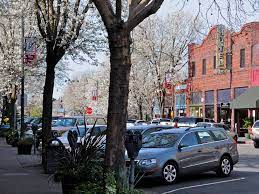Luke Lindenbusch | June 2021
Earlier this month, the Santa Rosa City Council unanimously approved the sale of Parking Lot 2 at 410 B Street to Cornerstone Properties. Cornerstone plans to replace the surface lot with a mixed-use, high-rise development, 15 percent of which will be affordable homes. Councilmember Victoria Fleming described the sale as “a pivotal turning point for the development of our downtown,” as the City of Santa Rosa has considered how to replace an excess of parking with housing for decades.
“It seems so easy now just to read the resolution, and it’s easily forgotten how much work went into this, and how many years of effort,” reflected Councilmember John Sawyer. “This is a catalyst project, and something we’ve been waiting for.”
“Catalyst projects” are identified in the 2020 Downtown Station Area Specific Plan (DSASP) as key sites for housing and economic development, and require a minimum of half the allowed density. Cornerstone is leading the charge on Lot 2 and another catalyst site, the large vacant parcel west of the Railroad Square SMART station. Meanwhile, Lot 7 on E Street is poised for development as a joint Civic Center of city and county government.
“What we’re missing in Santa Rosa is a proof of concept,” Santa Rosa Mayor Chris Rogers acknowledged. “Something we’ve talked about a number of times with our downtown is getting those developments first across the finish line to show not just the other developers, but the finance folks that these projects can actually make it in Santa Rosa.”
Mayor Rogers is right: bold projects will help spur further housing development in Downtown Santa Rosa. Streamlining measures have made building in Santa Rosa much easier, but only tangible results provide confidence that development is viable.
Cornerstone is among a number of developers proposing building on a smaller footprint as well. 556 Ross Street will provide homes just around the corner from Lot B on another surface parking lot. Development without displacement is possible when sites that aren’t serving a public benefit—empty parking lots, low-rise commercial buildings, or shuttered shopping malls—can help absorb the impact of an intensifying housing market with a greater supply of homes available at all income levels.
The inefficiency of sprawling lots has not always been apparent or accepted, and opposition to new housing frequently centers around perceived lack of parking. The City of Santa Rosa’s 2017 parking study found that Lot 2 didn’t surpass 85% occupancy at peak hours. The terms of Lot 2’s sale require replacement of the 144 public parking spaces in the new development, yet several community members offering public comment questioned the need to replace it at all due to an abundance of nearby options. This reversal in public sentiment indicates a growing understanding that building cities around cars is not conducive to city-centered growth or alignment with climate action goals.
Here are two actions you can take today to support homes for people instead of homes for cars:
In the state legislature, Generation Housing has endorsed Assembly Bill 1401 along with the Greenbelt Alliance, Natural Resources Defense Council (NRDC), and many housing organizations. AB 1401 would remove onerous parking requirements for residential and commercial buildings near frequent transit. Parking requirements exceed the true need for parking and ratchet up the cost of construction by as much as $80,000 per space, with added costs passed onto residents in the form of higher rents. Click here to add your support for AB 1401, which will help ease car dependence where it makes the most sense.
Santa Rosa is the largest of nine cities in Sonoma County with potential catalyst sites for housing. The Housing Element is a two-year process that, in part, identifies and rezones sites for housing development in the next decade. Learn more about getting involved with the Housing Element process can help ensure that your city’s parking lots and other underutilized sites don’t remain stuck in neutral.

